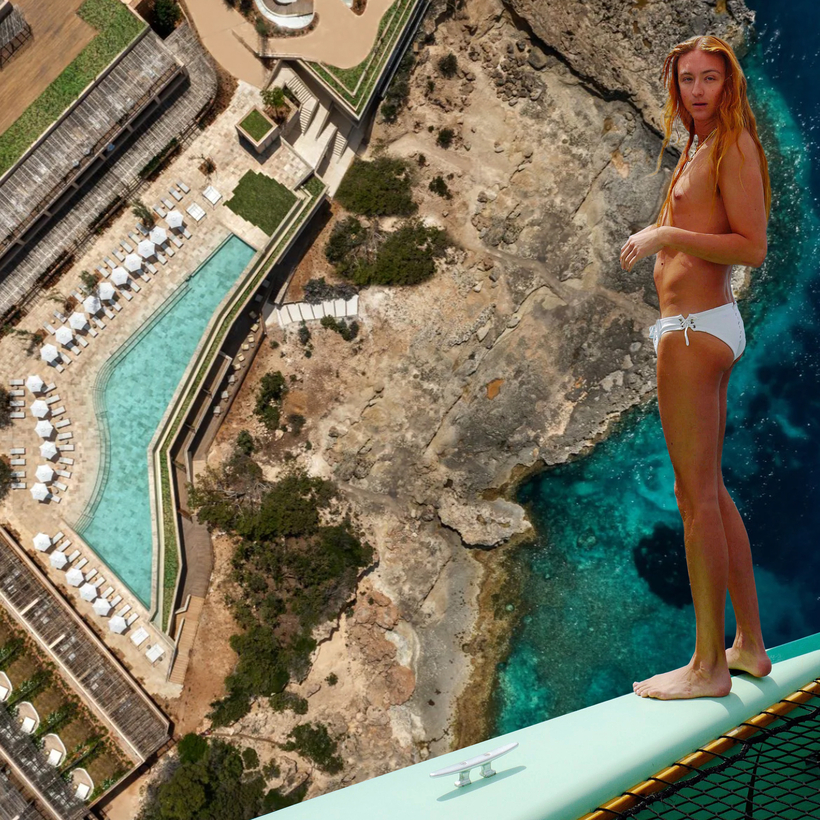Sitting underneath the fairy lights at La Paloma, Ibiza’s coolest restaurant, for dinner, you’ll notice two types of people.
The first are girls wearing diamond earrings and sequined dresses, with Saint Laurent clutches draped over their chairs. They represent what Ibiza, until very recently, had come to be known for: champagne, cocaine, and Paris Hilton, formerly resident D.J. at the Spanish island’s most popular nightclub.
The second are the reincarnations of Ibiza’s bohemian past, particularly the 80s, when Eric Clapton and Freddie Mercury danced barefoot on the beach. These are the island’s New Age hippies, and the fact that a hummus is 15 euros a pop is as little of a deterrent to them as it is to their trashy counterparts.
Since the pandemic, the island has made concrete steps toward reclaiming its sanctuary status for well-heeled wellness freaks. A cultural divide resembling the Rajneesh-versus-Antelope brawl of Wild Wild Country—the 2018 documentary on the guru–cum–cult leader Bhagwan Shree Rajneesh, who relocated his radical community of followers from India to Antelope, Oregon—has begun to emerge. And everyone’s talking about it.

“Our island has been so abused, and raped, and pillaged through the party scene,” an islander originally from London says. “Now wellness is finally taking center stage.”
Recent stories in the Financial Times and The Times of London have detailed how wealthy people from creative industries are moving to the island in droves. The celebrated landscaper Juan Masedo, the novelist Rebecca Frayn, and the model and activist Arizona Muse have all moved there. The “energy-positive” hotel chain Six Senses recently opened an Ibiza location. To cater to the new arrivals, expensive housing developments centered around wellness, such as Sabina and Fincadelica, have followed.
Since the pandemic, Ibiza has started reclaiming its sanctuary status for hippies and well-heeled wellness freaks.
But what all the press has failed to mention is that this is no ordinary wellness wave. In its great swing back from the hard-partying scene Ibiza grew to inhabit in the last 20 or so years, the island has taken things a step further than yoga and green juice, quickly becoming a hub for spiritual doctrines, alternative medicine, and cult-like rendezvous.
“In the South, cocaine and MDMA flow,” one Italian expat says. “In the North, it’s all about ceremonies—ayahuasca, peyote, cacao.”
As club manager at Sabina, Anton Bilton’s new building development, where the cheapest houses start at $4.5 million, Amit Segev, who is also a co-owner of La Paloma, presides over lazy members-only lunches, pairing herb-flecked mezze with natural wines. The vision, according to The Wall Street Journal, was a “luxury, family-friendly Burning Man for the global elite.”

At night, the clubhouse is open to the public. A Buddha statue floats ominously above the pool, while a temple sits casually next to the restaurant. On an adjacent wall, a painting of a human, half disfigured, breaks out into flowers.
“Here, on Wednesdays, is where they give out mushrooms,” says Barbara Romano, an Italian native who has lived on the island for 10 years. The events are organized by Segev. “Sometimes we chant together. It’s a beautiful moment, when everyone sings together and opens up their throat chakras.”
“The temple is where we celebrate Mother Nature,” another person at Sabina says. “We call to the stars, the sea, the moon, and our souls.”

The wildest affairs happen at Fincadelica, a 300-year-old, 21-acre “magical, free-flowing concept estate inspired by nature and tranquility” that Segev stumbled upon in 2019 and revived alongside the Israeli diamond dealer Mati Rachminov and businessman Shai Bencazir. The asking price is around $68,000 a week, a package that includes nine luxury suites, farm-to-table food, a soundproof cave club and a Lakota tepee complete with a resident shaman.
“When it’s free, during low season,” Romano says, “they light up the cacti fields for parties, as well as fields of crystals. Then waiters serve San Pedro chocolate mousse on platters.” The mousse is mixed with peyote, a cactus-based psychedelic.
“In the South, cocaine and MDMA flow. In the North, it’s all about ceremonies—ayahuasca, peyote, cacao.”
Segev, who is Israeli, knows a thing or two about wild affairs. His former mother-in-law, Prasuna Coppini, who is also La Paloma’s executive chef, was a part of the Rajneesh community. She is one of as many as 200 “sannyasis,” as the red-clothed followers of Rajneesh are called, who have relocated to Ibiza.
This sannyasi community, as well as Buddhists and Tantrists, make up the spiritual network of Ibiza. And with Sabina, Fincadelica, and many other similar establishments that have cropped up recently, radical spirituality is going mainstream, with more and more visitors trading nights at the popular techno club Ushuaïa for expensive, weekend-long retreats of full-moon dancing, chakra balancing, and lots of psychedelics.
“When I began Ibiza retreats, 15 years ago,” says Larah Davis, the founder of holistic wellness company Avatara, “there were only four retreats locations on the island … now they’ve really mushroomed.” Some of these companies, like Avatara, are about yoga and holistic wellness. Others—like Shambala, another sannyasi who is originally German, and her followers—celebrate full moons by “getting naked, spreading honey on one another, then putting flowers on the honey and dancing.”

Then there are the secret, invitation-only affairs, usually held at private houses, where shamans, or “curanderos,” are flown in from Brazil and Peru to preside over ayahuasca and peyote ceremonies. Hosted by different organizers, weekend-long stays, which are said to cure trauma, often cost upward of $3,000.
“There’s an application process,” says Tassilo Wolf, who recently attended an ayahuasca session on Ibiza. “You need to know someone, and they send you an e-mail with the details.”
On Wolf’s first night of the session, held at a private villa near the northern town of Santa Eularia, a Canadian shaman blessed everyone’s “souls and spirits” in a pitch-black room. Then, tea was served. “We all had buckets and toilet paper,” he says. “It was quiet for 45 minutes, I heard singing, and then I heard people around me crying and puking.” He continues: “At three, when it was all over, we danced around a bonfire.”
Another visitor to Ibiza who preferred not to be named outlined the menu at a retreat he attended recently for north of $4,500 dollars for a weekend. “There was a cacao ceremony, mixed with a bit of peyote. Then you’ve got ayahuasca, temazcal, then you have other stuff as well. You have breathwork ceremonies, DMT ceremonies.”
At House of Colors, a healing retreat, a descendant of the indigenous Mexican Yoreme people directed a fire-purification ritual and sexual cleansing, followed by consumption of an ancient cactus medicine from Mexico’s Wirikuta desert. A brochure for the retreat was sent to selected e-mail addresses.
“Most Ibicencans are Christians, but they tolerate all crazy types of people, may they be Osho people, Indian gurus, Tantra people,” Shambala explains.
Suddenly, Davis says, “it’s like living in an ashram,” but more louche. Psychedelics, anyone?
Elena Clavarino is an Associate Editor for Air Mail


